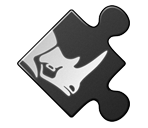Offsetting Curves on Surfaces
Windows only
Problem
You are using the RhinoOffsetCurveOnSrf function to offset a curve which was interpolated on a cylindrical surface. The problem is that the results do not seem to match those of Rhino’s OffsetCrvOnSrf command. That is, the offset curve does not extend to the edges of the surfaces. Why is this?
Solution
After calculating the offset curve, the OffsetCrvOnSrf command extends both ends of that curve to the surface edge using RhinoExtendCrvOnSrf. Below is an sample of how you can do this using the SDK…
Sample
CRhinoCommand::result CCommandTest::RunCommand( const CRhinoCommandContext& context )
{
// Select curve on surface
CRhinoGetObject gc;
gc.SetCommandPrompt( L"Select curve on surface" );
gc.SetGeometryFilter( CRhinoGetObject::curve_object );
gc.GetObjects( 1, 1 );
if( gc.CommandResult() != CRhinoCommand::success )
return gc.CommandResult();
// Validate curve
const ON_Curve* crv = gc.Object(0).Curve();
if( 0 == crv )
return CRhinoCommand::failure;
// Select base surface
CRhinoGetObject gs;
gs.SetCommandPrompt( L"Select base surface" );
gs.SetGeometryFilter( CRhinoGetObject::surface_object );
gs.EnablePreSelect( false );
gs.EnableDeselectAllBeforePostSelect( false );
gs.GetObjects( 1, 1 );
if( gs.CommandResult() != CRhinoCommand::success )
return gs.CommandResult();
// Validate face
const ON_BrepFace* face = gs.Object(0).Face();
if( 0 == face )
return CRhinoCommand::failure;
// Validate brep
const ON_Brep* brep = face->Brep();
if( 0 == brep )
return CRhinoCommand::failure;
// Specify offset distance
CRhinoGetNumber gd;
gd.SetCommandPrompt( L"Offset distance" );
gd.SetDefaultNumber( 1.0 );
gd.GetNumber();
if( gd.CommandResult() != CRhinoCommand::success )
return gd.CommandResult();
double dist = gd.Number();
// Do offset curve on surface
double tol = context.m_doc.AbsoluteTolerance();
ON_SimpleArray<ON_Curve*> offset_curves;
CRhinoCommand::result cmdrc = RhinoOffsetCurveOnSrf( crv, brep, face->m_face_index, dist, tol, offset_curves );
if( cmdrc == CRhinoCommand::success )
{
int i = 0;
ON_SimpleArray<const ON_Curve*> curves_to_join;
curves_to_join.Append( offset_curves.Count(), offset_curves.Array() );
// Try joining the offset curves
ON_SimpleArray<ON_Curve*> joined_curves;
BOOL rc = RhinoMergeCurves( curves_to_join, joined_curves, 2.0 * tol, TRUE );
for( i = 0; i < curves_to_join.Count(); i++ )
curves_to_join[i] = 0;
if( rc )
{
for( i = 0; i < joined_curves.Count(); i++ )
{
ON_Curve* pC = joined_curves[i];
if( pC )
{
// Extend both ends to edge of the surface
if( !pC->IsClosed() )
RhinoExtendCrvOnSrf( *face, pC );
// Add to document
CRhinoCurveObject* crv_obj = new CRhinoCurveObject();
crv_obj->SetCurve( pC );
context.m_doc.AddObject( crv_obj );
joined_curves[i] = 0;
}
}
// Do not leak memory
for( i = 0; i < offset_curves.Count(); i++ )
{
if( offset_curves[i] )
{
delete offset_curves[i];
offset_curves[i] = 0;
}
}
}
else
{
for( i = 0; i < offset_curves.Count(); i++)
{
ON_Curve* pC = offset_curves[i];
if( pC )
{
// Extend both ends to edge of the surface
if( !pC->IsClosed() )
RhinoExtendCrvOnSrf( *face, pC );
// Add to document
CRhinoCurveObject* crv_obj = new CRhinoCurveObject();
crv_obj->SetCurve( pC );
context.m_doc.AddObject( crv_obj );
offset_curves[i] = 0;
}
}
}
}
context.m_doc.Redraw();
return CRhinoCommand::success;
}

